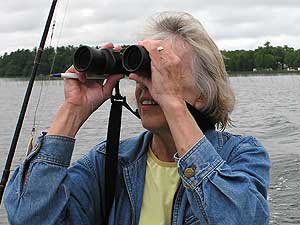|
Audio
Photos
Resources
|
July 12, 2005
 |
| Hundreds of volunteers count loons on Minnesota lakes in early July each year. (MPR Photo/Dan Gunderson) |
Moorhead, Minn. — Ruth Berquist participates in the Minnesota loon count every year. She's been gathering data since the project began in 1994.
She spent summers growing up at a cabin on Round Lake in Becker County, and she and her husband, Willie, moved there after they retired in 1991. The loon count gives her a reason to do something she loves: exploring the outdoors.
People who live around the lake are fascinated by the often reclusive loons, says Berquist.
"People love to hear them call. In the later part of July when they start gathering you really hear the sounds especially in the evening," says Berquist. "If you're quiet they will come around. They get curious. I'll go swimming and I can get really close to a loon if I'm really quiet, they start wondering who you are and come around."
On an early July morning, Willie drives the boat slowly along the shoreline as Ruth peers through binoculars. Loons can be hard to spot among the cattails along the shore.
Berquist painstakingly searches for the fluffy brown chicks she hopes to find bobbing near the adult loons. On this day Berquist counts seven adults and four chicks on Round Lake.
The data collected by nearly 1,000 volunteers across the state gives a good indication of loon population trends. It also gives the Minnesota Department of Natural Resources a database it could never maintain on its own.
The loon population has generally been stable over the past decade. But there are some concerns about the health of loons.
Loons aren't producing as many young as expected in some parts of the state, according to DNR Nongame Specialist Katie Haws.
"For example, in the northeast part of the state where a high percentage of the lakes had loons, the productivity wasn't as good as we were expecting. So we want to explore whether there is something going on that's causing those eggs not to hatch or if there's any kind of a health problem with the loon population," says Haws.
The DNR plans to study the problem, and they're asking anyone who finds a dead loon this summer to call a local DNR conservation officer who will collect the dead bird. The dead loons will be examined for lead and mercury levels, says Katie Haws.
Loons can die from eating lead fishing tackle abandoned in lakes. Air pollution causes increased mercury levels in water and fish.
Haws says researchers hope to collect up to 100 dead loons over the next couple of years to learn more about the health of the Minnesota state bird.
"I wake up every morning to the loon call on Blackduck Lake, and it never ceases to thrill me. I just hope we continue to hear those loons in years to come and hopefully by doing this work we can detect any problems before they become too severe," says Haws.
Haws says better understanding the health of the loon population might also provide some important insights to the health of Minnesota lakes.




